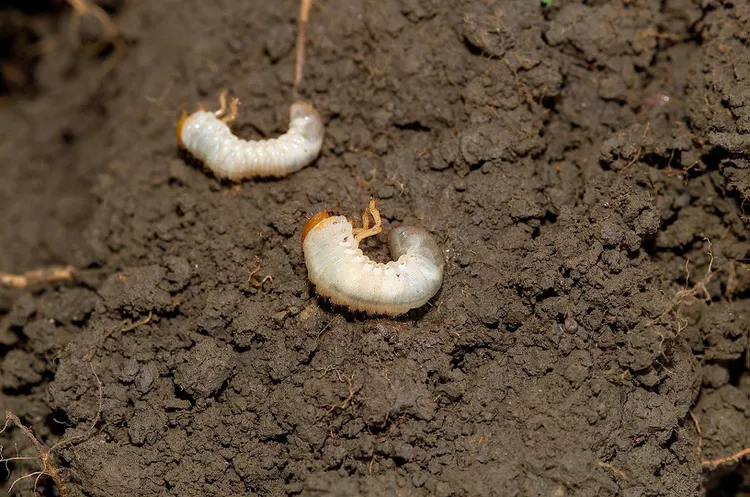If in July or August, your grass turns brown and is easy to pull up, or you notice a lot of critters, such as skunks or raccoons, tearing up your lawn, it may be infested with grubs. White grubs are the larvae of Japanese beetles, June beetles, or masked chafer beetles. They cause damage to lawns by feeding on the roots of grass.
To get rid of white grubs, it is key to identify which grubs are in your lawn and understand their life cycle because successfully treating grubs is all about timing.
Identifying the Pest
Depending on the species, grubs may have a one-year to three-year life cycle.
Annual white grubs are the larvae of the Japanese beetle, masked chafer beetle, and others. They begin their life cycle in mid- to late summer, grow quickly, and do most of their feeding in late summer.
Multi-annual white grubs are the larvae of several species of June beetles that take two to three years to complete their life cycle. They emerge in May or June, feed during the summer and fall, and overwinter deep in the soil.
When to Control Grubs
Controls are most effective on immature grubs. For most species and locations that means July or August is the prime time to treat the grubs with an insecticide. However, because grub populations vary from year to year, you may be able to save the cost of treatment if you first sample your lawn to estimate how many grubs are present:
- Dig up several pieces of sod about a foot square.
- If you find five or fewer grubs per square foot, you need not apply grub control. The lawn will withstand the amount of feeding these few grubs do.
- If 10 or more grubs are present, treat your lawn.
- If the average count is between five and 10, whether or not to control depends on the health of your lawn, your tolerance for damage to the lawn, and the presence of natural controls.
A healthy, well-maintained lawn is less prone to grub damage than a stressed lawn. Select a suitable type of turfgrass for your climate, feed the lawn without overfertilizing it, and follow other tips for proper lawn care. Check out the seasonal lawn-care schedules for the Northeast, Midwest, Pacific Northwest, and Southern California.
Natural Grub Control
Milky Spore
Milky spore (Paenibacillus popilliae) is a natural bacterium that can effectively control Japanese beetle grubs by causing a chronic infection in Japanese beetle grubs and diminishing their reproduction numbers over time. The downside is that milky spore usually takes several years to take effect. Furthermore, it requires some grubs to live on, so don't use it together with chemical controls. Milky spore comes in powder form and it is only effective on Japanese beetle grubs.
Nematodes
Beneficial nematodes are microscopic worms that live in the soil. They seek out grubs, and after entering their bodies, release bacteria that act as killers. The two major types of insect parasitic nematodes are Steinernema spp. and Heterorhabditis spp. The nematodes are applied as a live product, so make certain that they are alive, that they've been handled carefully, and that their shelf life has not expired. These two types of nematodes are effective on all types of grubs.
Weather and Irrigation
Grub populations are usually the highest when soil conditions are consistently moist. In dry years, or if you withhold irrigation water during hot summer months, many grubs will not survive. This strategy may work well for bluegrass lawns, which recover well from summer dormancy.
Chemical Grub Control
Because grub populations vary considerably from year to year, preventive chemical controls are seldom justified. But if your lawn is consistently attacked by grubs, you might want to consider applying a chemical insecticide. Chemicals labeled for curative control are carbaryl, halofenozide, and imidacloprid. You must apply these chemical controls at the correct time when the grubs are small and actively feeding near the soil surface, usually from early July until mid-August.
Water in the chemical controls how they penetrate the soil and act on the grubs. Watering the lawn after chemical application not only moves the product down into the thatch layer, it also stimulates the grubs to move upward in the soil, closer to the chemical.
Most insecticides not only kill white grubs but they are also highly toxic to bees and other pollinating insects. Always use chemical insecticides as the last resort, weigh how long they are effective against grubs vs. their potential risks, and carefully follow the label instructions before applying the product.




















